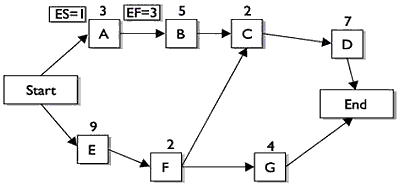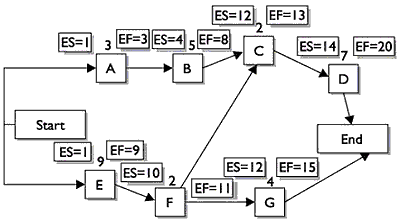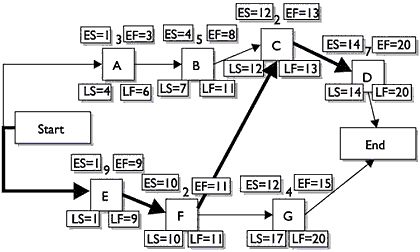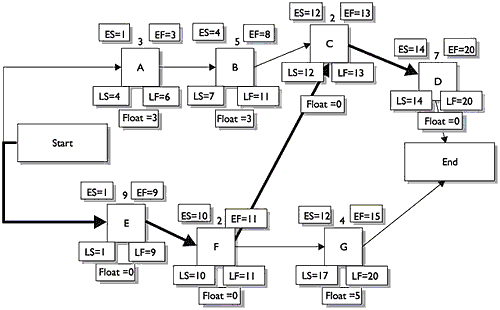Version [18222]
Dies ist eine alte Version von PmNwCriticalPath erstellt von RonnyGertler am 2012-12-12 19:17:54.

Project Network Diagram and Critical Path
Inhalte von Prof. Dr. Kurt Englmeier
Examine the PND and find the critical path. The critical path is typically the path with the longest duration and will always have zero float. The critical path is technically found once you complete the forward and backward pass. Start with the forward pass. After the backward pass, you can identify the critical and near critical paths, as well as float.
1. The early start (ES) and early finish (EF) dates are calculated first by completing the "forward pass." The ES of the first task is one. The EF for the first task is its ES, plus the task duration, minus one. Don't let the "minus one value" throw you. If Task A is scheduled to last one day, it would only take one day to complete, right? The ES would be 1, the duration is 1, and the EF would also be 1 because the activity would finish within one day, not two days. The following illustration shows the start of the forward pass.

2. The ES of the next task(s) will be the EF for the previous activity, plus one. In other words, if Task A finishes on day eight, Task B will begin on day nine.
3. The EF for the next task(s) equals its ES, plus the task duration, minus one. Sound familiar?
4. Now each task moves forward with the forward pass. Use caution when there are predecessor activities; the EF with the largest value is carried forward. The following illustration shows the completed forward pass.

5. After the forward pass is completed, the backward pass starts at the end of the PND. The backward pass is concerned with the late finish (LF) and the late start
(LS) of each activity. The LF for the last activity in the PND equals its EF value. The LS is calculated by subtracting the duration of the activity from its LF, plus one. The one is added to accommodate the full day's work; it's just the opposite of subtracting the one day in the forward pass. Here's a tip: The last activity is on the critical path, so its LS will equal its ES.
6. The next predecessor activity's LF equals the LS of the successor activity, minus one. In other words, if Task Z has an LS of 107, Task Y will have an LF of 106. The following illustration shows the process of the backward pass.

7. The LS is again calculated by subtracting the task's duration from the task's LF, plus one. The following shows the completed backward pass.

8. To off icially calculate float, the LS is subtracted from the ES and the LF is subtracted from the EF. Recall the total float is the amount of time a task can be
delayed without delaying the project completion date. The next illustration shows the completed PND with the float exposed.

CategoryPmMa
Diese Seite wurde noch nicht kommentiert.





